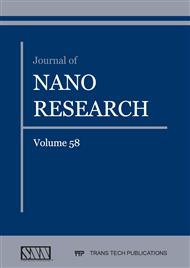[1]
D.C. Radisky, Epithelial-mesenchymal transition. J. Cell. Sci. 118 (2005) 4325-4326.
Google Scholar
[2]
J.P. Thiery, H. Aclogue, R.Y.J. Huang, M. Angela Nieto, Epithelial-mesenchymal transitions in development and disease. Cell. 139 (2009) 871-890.
DOI: 10.1016/j.cell.2009.11.007
Google Scholar
[3]
K. Polyak, R.A. Weinberg, Transitions between epithelial and mesenchymal states: acquisition of malignant and stem cell traits. Nat. Rev. Cancer. 9 (2009) 265-273.
DOI: 10.1038/nrc2620
Google Scholar
[4]
R. Amerongen, R. Nusse, Towards an integrated view of Wnt signaling in development. Development. 136 (2009) 3205-3214.
DOI: 10.1242/dev.033910
Google Scholar
[5]
B. Lustig, J. Behrens, The Wnt signaling pathway and its role in tumor development. J. Cancer. Res. Clin. Oncol. 129 (2003) 199-221.
DOI: 10.1007/s00432-003-0431-0
Google Scholar
[6]
X. Wang, L. Yang, Z. Chen, M. Dong, Application of nanotechnology in cancer therapy and imaging. CA: Cancer. J. Clin. 58 (2008) 97-110.
Google Scholar
[7]
E.E. Connor, J. Mwamuka, A. Gole, C.J. Murphy, M.D. Wyatt, Gold nanoparticles are taken up by human cells but do not cause acute cytotoxicity. Small. 1 (2005) 325-327.
DOI: 10.1002/smll.200400093
Google Scholar
[8]
M.C. Daniel, D. Astruc, Gold nanoparticles: assembly, supramolecular chemistry, quantum-size-related properties, and applications toward biology, catalysis, and nanotechnology. Chem. Rev. 104 (2004) 293-346.
DOI: 10.1021/cr030698+
Google Scholar
[9]
D.C. Julien, S. Behnke, G. Wang, G.K. Murdoch, R.A. Hill, Utilization of monoclonal antibody-targeted nanomaterials in the treatment of cancer. MAbs. 3 (2011) 467-478.
DOI: 10.4161/mabs.3.5.16089
Google Scholar
[10]
R. Singh, H.S. Nalwa, Medical applications of nanoparticles in biological imaging, cell labeling, antimicrobial agents, and anticancer nanodrugs. J. Biomed. Nanotechnol. 7 (2011) 489-503.
DOI: 10.1166/jbn.2011.1324
Google Scholar
[11]
L.A. Dykman, N.G. Khlebtsov, Gold nanoparticles in biology and medicine: recent advances and prospects. Acta. Naturae. 3 (2011) 34-55.
DOI: 10.32607/20758251-2011-3-2-34-55
Google Scholar
[12]
L. You, B. He, K. Uematsu, Z. Xu, J. Mazieres, et al, Inhibition of Wnt-1 signaling induces apoptosis in beta-catenin-deficient mesothelioma cells. Cancer. Res.64 (2004) 3474-3478.
DOI: 10.1158/0008-5472.can-04-0115
Google Scholar
[13]
B. He, L You, K. Uematsu, Z. Xu, A. Lee, M. Matsangou, A monoclonal antibody against Wnt-1 induces apoptosis in human cancer cells. Neoplasia. 6 (2004).7-14.
DOI: 10.1016/s1476-5586(04)80048-4
Google Scholar
[14]
S.K. Sivaraman, S. Kumar, V. Santhanam, Monodisperse sub-10 nm gold nanoparticles by reversing the order of addition in Turkevich method--the role of chloroauric acid. J. Colloid. Interface. Sci. 361 (2011) 543-547.
DOI: 10.1016/j.jcis.2011.06.015
Google Scholar
[15]
J. Turkevich, P.C. Stevenson, J. Hillier, A Study of the Nucleation and Growth Processes in the Synthesis of Colloidal Gold. Discussions of the Farady Society. 11 (1951). 55-75.
DOI: 10.1039/df9511100055
Google Scholar
[16]
A. Sharma, Z. Matharu, G Sumana, P.R. Solanki, et al, Antibody immobilized cysteamine functionalized-gold nanoparticles for aflatoxin detection. thin solid films. 519 (2010) 1213-1218.
DOI: 10.1016/j.tsf.2010.08.071
Google Scholar
[17]
M. Losurdo, P.C. Wu, T.H. Kim, G. Bruno, A.S. Brown, Cysteamine-based functionalization of InAs surfaces: revealing the critical role of oxide interactions in biasing attachment. Langmuir. 28 (2012) 1235-1245.
DOI: 10.1021/la203436r
Google Scholar
[18]
G Arya, M Vandana, S Acharya, SK Sahoo. , Enhanced antiproliferative activity of Herceptin (HER2)-conjugated gemcitabine-loaded chitosan nanoparticle in pancreatic cancer therapy. Nanomedicine. 7 (2011). 859-870.
DOI: 10.1016/j.nano.2011.03.009
Google Scholar
[19]
NE Vrana, N Builles, H Kocak, P Gulay, V. Justin, EDC/NHS cross-linked collagen foams as scaffolds for artificial corneal stroma. J. Biomater. Sci. Polym. Ed. 18 (2007) 1527-1545.
DOI: 10.1163/156856207794761961
Google Scholar
[20]
B.D. Chithrani, A.A. Ghazani, W.C. Chan, Determining the size and shape dependence of gold nanoparticle uptake into mammalian cells. Nano. Lett. 6 (2006). 6(4) 662-668.
DOI: 10.1021/nl052396o
Google Scholar
[21]
T. Mosmann, Rapid colorimetric assay for cellular growth and survival: application to proliferation and cytotoxicity assays. J. Immunol. Methods.65 (1983). 55-63.
DOI: 10.1016/0022-1759(83)90303-4
Google Scholar
[22]
S Greenland, S.J. Senn, K.J. Rothman, J.B. Carlin, et al, Statistical tests, P values, confidence intervals, and power: a guide to misinterpretations. Eur. J. Epidemiol.31 (2016). 337-350.
DOI: 10.1007/s10654-016-0149-3
Google Scholar


